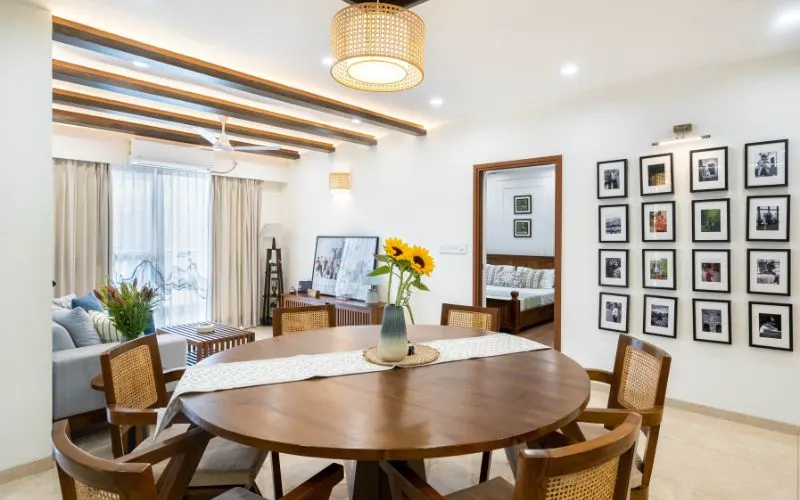- chitralekha@ceebeedesignstudio.com
- Home Owner Bangalore - +91 8697306015
- Home Owner Kolkata - +91 8697306015
- Other Enquiry - +91 91470 08329

By :
CeeBeeDesignStudio

June 10, 2025

Interior design has always been about making a space look good. But sensorial design goes a step further. It’s about creating an emotional and physical connection through texture, lighting, scent, and sound, making a home more personal and cosy.
Are you too looking to take your daily living to the next level by engaging all five senses? It’s time! All you need to do is blend sensorial design elements with thoughtful home interior design for a wholesome vibe. But, how exactly? That’s what this blog is about, so you don’t overwhelm yourself. Here’s how you can transform your home into a haven that speaks to all your senses.
The true beauty of sensorial interior design lies in how these sensory elements work together. Here’s how you can amp up your home’s interior design game by elevating your senses.
1. Sight: A Blend of Visual Harmony
The first interaction we have with any space is visual. Sensorial design starts by curating an interior design palette that reflects calm, joy, or opulence. This depends on your intention for each room. Follow the tips given below to maximise visual impact through light, colour, and space.
Hire interior design companies that use backlit panels and custom art installations. This will help you anchor the visual story of each space.
2. Touch: Textures that Invite Interaction
A well-designed room should make you want to reach out and feel it. Tactile experience can provide an element of comfort that visual design cannot replicate. Spaces with sensory interiors help bring connectedness to the space. Examples of luxe tactile components could include:
3. Smell: Signature Scents for Every Room
Scent plays a powerful role in memory and mood. High-end spaces often have signature scents. This is a subtle but defining element that lingers in the background. Sensorial design is incomplete without scent. Take a look at a few ideas for how to add scent to your space outlined below:
4. Sound: Curated Acoustics and Ambient Tones
Sound affects how calm or energised we feel in a space. In luxury design, acoustics are not afterthoughts. They are essential to creating a serene atmosphere. Hire home interior designers in Bangalore who often work with acoustic consultants. This will ensure each space sounds as beautiful as it looks. Elevate the soundscape by following the steps below:
5. Taste: A Sensory Journey into Culinary Design
Taste may seem separate from design. But it has a surprising role. Kitchen and dining areas designed with indulgence in mind can elevate the dining experience. Integrate the following elements in your kitchen and dining zones. These elements will make the areas not just functional but experimental.
To enrich your living environment through sensorial, luxury interiors, trust a leading company like CeeBeeDesignStudio. Our home interior design solutions engage all five senses: sight, sound, touch, smell, and even taste. From peaceful bedrooms to lively living spaces, we create homes that feel immersive and balanced.
Sensorial interior design is the future of luxury home interiors. It produces homes that don't just look beautiful. But also emphasise your well-being by engaging all of your five senses. Incorporate elements of each of the senses into your home interior design. Go with an interior designer who takes pride in designing spaces that tell a story. A personal story that nurtures every sense every day. This will help create a home for you that feels as luxurious as it looks.
What is sensorial interior design?
Sensorial design uses all five senses, not just visual appeal. The goal is to create a total sensory experience.
Is there a difference in sensorial design when you work with smaller homes?
Not at all. Even in smaller homes, sensorial design makes a big difference. Things like soft textures, warm lighting, or a familiar scent can completely shift the way a space feels. Sometimes, these little touches matter even more in a compact space.
How do I start with designing a sensorial space?
Take one sense at a time. Start with lighting and textures. Incorporate scents through candles or diffusers. Add soft music in the background. Use rich materials in your dining setup, etc.
Why is sensorial design an important part of home interiors?
Sensorial design enhances comfort, mood, and overall well-being. When all of your senses are engaged, your home becomes your sanctuary. This enables you to express yourself and feel happier and rejuvenated overall.
Cee Bee Design Studio is a top-tier interior design consultancy, excelling in Interior Decoration and Turn Key Execution of Interior Works. With a strong presence in Kolkata and Bangalore, we have transformed over 1000+ residential projects and 300+ commercial spaces. Our team's commitment to excellence and innovation ensures a remarkable design experience for every client. Let's bring your dream space to life.
How To Incorporate Wash Basin Designs Into...
By: CeeBeeDesignStudio10 Home Library Designs To Revamp Your Reading...
By: CeeBeeDesignStudio7 Inspiring Bedroom Decor Ideas For The Season
By: CeeBeeDesignStudioHow To Decorate A Living Room On A Budget?
By: CeeBeeDesignStudio
